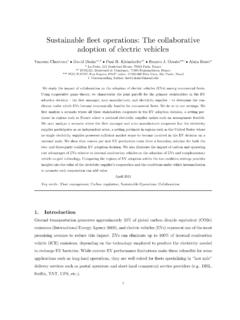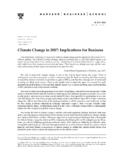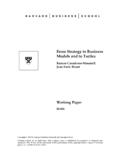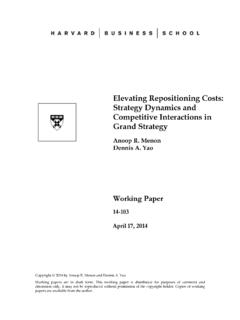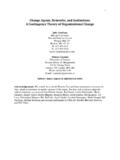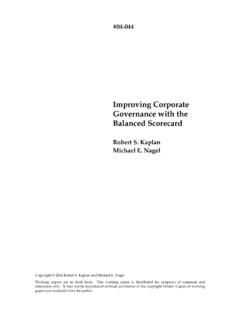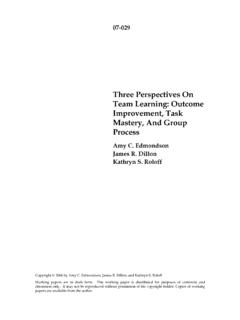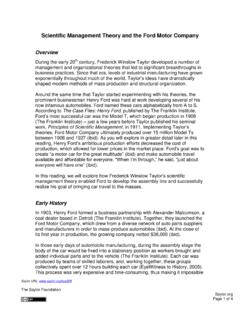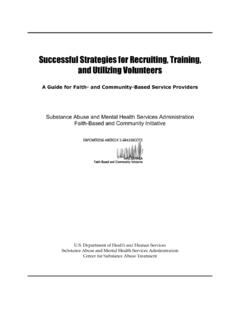Transcription of Goals Gone Wild: The Systematic Side Effects of Over ...
1 Copyright 2009 by Lisa D. Ord ez, Maurice E. Schweitzer, Adam D. Galinsky, and Max H. Bazerman Working papers are in draft form. This working paper is distributed for purposes of comment and discussion only. It may not be reproduced without permission of the copyright holder. Copies of working papers are available from the author. Goals Gone Wild: The Systematic Side Effects of Over-Prescribing Goal Setting Lisa D. Ord ez Maurice E. Schweitzer Adam D. Galinsky Max H. Bazerman Working Paper 09-083 Goals Gone Wild 1 Goals Gone Wild: The Systematic Side Effects of Over-Prescribing Goal Setting Lisa D. Ord ez Eller College of Management, University of Arizona Maurice E. Schweitzer Wharton School, University of Pennsylvania Adam D. Galinsky Kellogg School of Management, Northwestern University Max H. Bazerman Harvard Business School, Harvard University Goals Gone Wild 2 Abstract Goal setting is one of the most replicated and influential paradigms in the management literature.
2 Hundreds of studies conducted in numerous countries and contexts have consistently demonstrated that setting specific, challenging Goals can powerfully drive behavior and boost performance. Advocates of goal setting have had a substantial impact on research, management education, and management practice. In this article, we argue that the beneficial Effects of goal setting have been overstated and that Systematic harm caused by goal setting has been largely ignored. We identify specific side Effects associated with goal setting, including a narrow focus that neglects non-goal areas, a rise in unethical behavior, distorted risk preferences, corrosion of organizational culture, and reduced intrinsic motivation. Rather than dispensing goal setting as a benign, over-the-counter treatment for motivation, managers and scholars need to conceptualize goal setting as a prescription-strength medication that requires careful dosing, consideration of harmful side Effects , and close supervision.
3 We offer a warning label to accompany the practice of setting Goals . Goals Gone Wild 3 Goals Gone Wild: The Systematic Side Effects of Over-Prescribing Goal Setting For decades, goal setting has been promoted as a halcyon pill for improving employee motivation and performance in organizations. Across hundreds of experiments, dozens of tasks, and thousands of participants across four continents, the results are clear (Locke, Latham, Smith, & Wood, 1990). Compared to vague, easy Goals ( , Do your best ), specific, challenging Goals boost performance. In a review of four decades of goal-setting research, Locke and Latham (2006) claim, So long as a person is committed to the goal, has the requisite ability to attain it, and does not have conflicting Goals , there is a positive, linear relationship between goal difficulty and task performance. In this article, however, we contend that goal setting has been over-prescribed.
4 In particular, we argue that goal setting has powerful and predictable side Effects . Rather than being offered as an over-the-counter salve for boosting performance, goal setting should be prescribed selectively, presented with a warning label, and closely monitored. Emblematic Examples of Goals Gone Wild Here are just a few examples of the hazards of indiscriminate goal setting. First, consider Sears, Roebuck and Co. s experience with goal setting in the early 1990s. Sears set sales Goals for its auto repair staff of $147/hour. This specific, challenging goal prompted staff to overcharge for work and to complete unnecessary repairs on a companywide basis (Dishneau, 1992). Ultimately, Sears Chairman Edward Brennan acknowledged that goal setting had motivated Sears employees to deceive customers. Sears goal setting process for service advisers created an environment where mistakes did occur, Brennan admitted (Santoro & Paine, 1993).
5 Goals Gone Wild 4 In the late 1990s, specific, challenging Goals fueled energy-trading company Enron s rapid financial success. Ackman (2002) compares Enron s incentive system to paying a salesman a commission based on the volume of sales and letting him set the price of goods sold. Even during Enron s final days, Enron executives were rewarded with large bonuses for meeting specific revenue Goals . In sum, Enron executives were meeting their Goals , but they were the wrong Goals , according to employee compensation expert Solange Charas. By focusing on revenue rather than profit, Enron executives drove the company into the ground. In the late 1960s, the Ford Motor Company was losing market share to foreign competitors that were selling small, fuel-efficient cars. CEO Lee Iacocca announced the specific, challenging goal of producing a new car that would be under 2000 pounds and under $2,000 and would be available for purchase in 1970.
6 This goal, coupled with a tight deadline, meant that many levels of management signed off on unperformed safety checks to expedite the development of the car the Ford Pinto. One omitted safety check concerned the fuel tank, which was located behind the real axle in less than 10 inches of crush space. Lawsuits later revealed what Ford should have corrected in its design process: the Pinto could ignite upon impact. Investigations revealed that after Ford finally discovered the hazard, executives remained committed to their goal and instead of repairing the faulty design, calculated that the costs of lawsuits associated with Pinto fires (which involved 53 deaths and many injuries) would be less than the cost of fixing the design. In this case, the specific, challenging Goals were met (speed to market, fuel efficiency, and cost) at the expense of other important features that were not specified (safety, ethical behavior, and company reputation).
7 As these disasters suggest, the harmful Effects of goal setting have received far too little attention in the management literature. Although prior work has acknowledged pitfalls of goal Goals Gone Wild 5 setting (Latham & Locke, 2006), we argue that the harmful side Effects of goal setting are far more serious and Systematic than prior work has acknowledged. First, we begin by describing the Systematic and predictable ways in which goal setting harms organizations. We describe how the use of goal setting can degrade employee performance, shift focus away from important but non-specified Goals , harm interpersonal relationships, corrode organizational culture, and motivate risky and unethical behaviors. We argue that, in many situations, the damaging Effects of goal setting outweigh its benefits. Second, we offer a warning label to guide the use of goal setting. We identify specific questions managers should ask to ascertain whether the harmful Effects of goal setting outweigh the potential benefits.
8 Third, we call for further study of the adverse consequences of goal setting. Given the widespread endorsement and use of goal setting, we argue that the harmful Effects of goal setting deserve additional scholarly and managerial attention. How Goals Go Wild Advocates of goal setting argue that for Goals to be successful, they should be specific and challenging. Countless studies (see Locke & Latham, 2002, 2006) find that specific, challenging Goals motivate performance far better than do your best exhortations. According to these findings, specific Goals provide clear, unambiguous, and objective means for evaluating employee performance. Specific Goals focus people s attention; lacking a specific goal, employee attention may be dispersed across too many possible objectives. In turn, because challenging Goals , or stretch Goals , create a discrepancy between one s current and expected output, they motivate greater effort and persistence.
9 Goals Gone Wild 6 Although specific, challenging Goals can produce positive results, we argue that it is often these same characteristics of Goals that cause them to go wild. When Goals Are Too Specific As research has shown, Goals focus attention. Unfortunately, Goals can focus attention so narrowly that people overlook other important features of a task. Consider Simons and Chabris' (1999; Neisser, 1979) well-known study of inattentional blindness. The researchers asked participants to watch a video in which two groups of players pass basketballs. One group wears white shirts; the other group wears dark shirts. Given the task of counting basketball passes among people wearing only white shirts, people unconsciously block out the black shirted individuals. As a result of this narrow focus, most participants fail to notice when a man wearing a black gorilla suit saunters into the middle of the screen, pounds his chest, and walks off screen.
10 Intense concentration on the counting task causes people to overlook a striking element of their visual world. This focusing problem has broad application (Bazerman & Chugh, 2006) and direct relevance to goal setting. Narrow Goals . With Goals , people narrow their focus. This intense focus can blind people to important issues that appear unrelated to their goal (as in the case of Ford employees who overlooked safety testing to rush the Pinto to market). The tendency to focus too narrowly on Goals is compounded when managers chart the wrong course by setting the wrong goal ( , setting revenue rather than profit Goals at Enron). Setting appropriate Goals is a difficult, intricate process. Suppose that a university department bases tenure decisions primarily on the number of articles that professors publish. This goal will motivate professors to accomplish the narrow objective of publishing articles.
